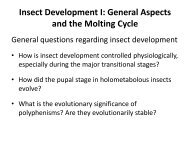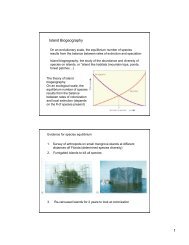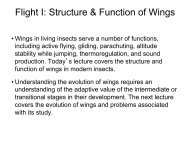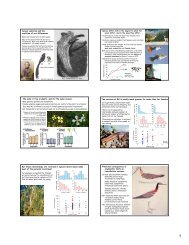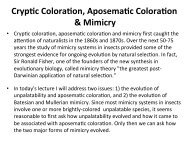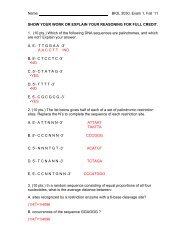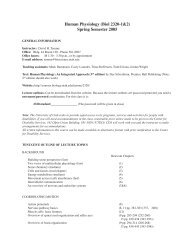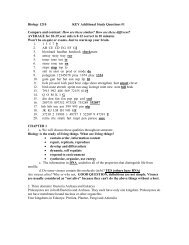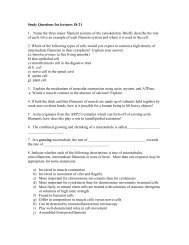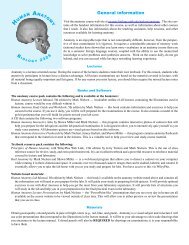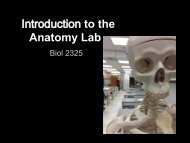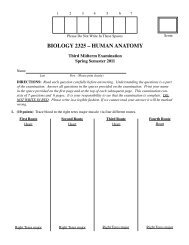Personal Statement I have had the privilege of being mentored by ...
Personal Statement I have had the privilege of being mentored by ...
Personal Statement I have had the privilege of being mentored by ...
You also want an ePaper? Increase the reach of your titles
YUMPU automatically turns print PDFs into web optimized ePapers that Google loves.
Research statementMy first undergraduate research experience was in Dr. Rosanna Giordano’s laboratory, where weexamined <strong>the</strong> par<strong>the</strong>nogenetic effect <strong>of</strong> endoparasitic bacteria in <strong>the</strong> genus Wolbachia onspringtails (Collembola: Folsomia candida). Wolbachia infects up to 75% <strong>of</strong> all arthropods andtargets reproductive tissues, manipulating reproductive strategies. Infection with Wolbachia cankill embryonic males, and cause feminization and par<strong>the</strong>nogenesis [1]. I aided in demonstratingthat Wolbachia infection was <strong>the</strong> cause <strong>of</strong> par<strong>the</strong>nogenesis in springtails. I helped determinewhich antibiotic treatments would be most effective to eliminate gram-negative Wolbachia in <strong>the</strong>springtails, and which antibiotics would serve as good controls in replicate springtailpopulations. I developed <strong>the</strong> protocol for making a food containing equal active portions <strong>of</strong>antibiotics. As predicted, <strong>the</strong> antibiotic treatments targeting gram-negative bacteria virtuallyeliminated par<strong>the</strong>nogenetic reproduction (unpublished data).As an undergraduate I also <strong>had</strong> <strong>the</strong> opportunity to become a field assistant to EllenMartinsen, a graduate student in Dr. Joseph Schall’s laboratory. Our research on avian malarialparasites became <strong>the</strong> foundation for my fascination with parasitology. Malarial parasites areprotozoans transmitted between hosts <strong>by</strong> biting insect vectors. The parasite undergoes sexualreproduction in <strong>the</strong> vector, and asexual reproduction in <strong>the</strong> host. Parasites are visible in <strong>the</strong> hostblood <strong>by</strong> light microscopy, and traditionally it has been through light microscopy that <strong>the</strong>y areidentified. There are three genera <strong>of</strong> malarial parasites that infect birds: Leucocytozoon,Haemoproteus, and Plasmodium. Ellen and I sampled more than 150 bird species, which Iquickly learned to identify <strong>by</strong> sight and call. For two summers we woke up before dawn,sampled sites all over Vermont using playback tapes to call birds into our mistnets, made bloodsmears from <strong>the</strong> hosts we sampled, and spent afternoons in <strong>the</strong> lab analyzing our data.My work focused on <strong>the</strong> diversity <strong>of</strong> <strong>the</strong> genus Plasmodium in birds <strong>of</strong> Vermont. Icombined traditional identification techniques (morphological characters examined <strong>by</strong> lightmicroscopy) with molecular techniques (gene sequencing through PCR) to determine iftraditional methods <strong>of</strong> parasite identification to subgenus are consistent with <strong>the</strong>ir placement on amolecular phylogenetic tree. Avian Plasmodium is currently divided into five subgenera <strong>by</strong>morphological characteristics [2], and so a maximum <strong>of</strong> five monophyletic clades consistent withmorphological identification could be expected. I used only heavy infections with replicates <strong>of</strong>all life stages <strong>of</strong> <strong>the</strong> parasite present in <strong>the</strong> blood smear for morphological identifications. I alsoconstructed a consensus molecular phylogeny using parsimony, maximum likelihood, andBaysian methods. I discovered that traditional methods <strong>of</strong> identification frequently result inconfusion between two subgenera. I identified consistent morphological characters for correctidentification <strong>of</strong> <strong>the</strong> o<strong>the</strong>r three subgenera that showed monophyletic clades [3]. Part <strong>of</strong> this workwas funded <strong>by</strong> competitive grants I was awarded: URECA! (Undergraduate Research EndeavorsCompetitive Awards) and HELiX (Hughes Endeavor for Life Science Excellence). I <strong>have</strong>presented this work formally*. Ellen has gone on to sequence ano<strong>the</strong>r mitochondrial gene toreinforce already strong phylogenetic support, and has added additional samples from sourcesoutside <strong>of</strong> Vermont to improve phylogenetic resolution, which are included in our publication[3]. This work has implications for identifying <strong>the</strong> adaptive significance <strong>of</strong> particularmorphological and life history traits <strong>of</strong> <strong>the</strong> parasites. Parasite identification is critical in humanmedicine and veterinary fields for diagnoses and treatments. In research, identification is <strong>the</strong>basis for addressing patterns <strong>of</strong> transmission and determining host specificity.I wanted to become more expert in molecular biology methods prior to entering graduate
school, as I <strong>had</strong> enjoyed this work in <strong>the</strong> Schall lab. Thus, I took <strong>the</strong> position <strong>of</strong> researchtechnologist in <strong>the</strong> lab <strong>of</strong> Dr. Jay Storz at <strong>the</strong> University <strong>of</strong> Nebraska-Lincoln and used a geneticbasedapproach to explore <strong>the</strong> adaptive evolution <strong>of</strong> deer mice to high altitudes. We studied <strong>the</strong>iralpha globin genes, which code for two subunits <strong>of</strong> <strong>the</strong> hemoglobin protein complex that bindsoxygen in blood cells. These mice <strong>had</strong> adaptive genetic polymorphisms that caused hemoglobinto bind oxygen more strongly at high altitudes (where oxygen is more scarce) and less strongly atlow altitudes, and <strong>the</strong> patterns <strong>of</strong> <strong>the</strong>se polymorphisms were similar among populations at similaraltitudes. I became skilled at molecular problem solving at <strong>the</strong> bench, tweaking PCRs andoptimizing cloning reactions. Additionally, I practiced sequence editing, phylogenetic treebuilding, and I learned how to use new s<strong>of</strong>tware. I enjoyed working independently andconversing and collaborating with colleagues to help solve problems and discuss project ideas.Two papers resulted from my research. One suggests how <strong>the</strong> polymorphisms are maintained indeer mouse populations, and <strong>the</strong> second looks at genetic variation in house mice betweenaltitudes [4,5].To get my “parasitology fix” while working in <strong>the</strong> Storz lab, I began a journal club at UNLand read journal articles weekly with parasitology graduate students, with intellectualcontributions from Dr. John Janovy, a pr<strong>of</strong>essor <strong>of</strong> parasitology. Working at UNL as a salariedfull time employee also allowed me to dedicate <strong>the</strong> majority <strong>of</strong> my vacation hours to taking athree-week intensive field course, in field parasitology, in Ogallala, NE. I learned much from Dr.Janovy about <strong>the</strong> diversity <strong>of</strong> parasites in nature. I also learned specimen preparation techniquesfor a wide array <strong>of</strong> taxa. Dr. Janovy’s talks, our research projects, and class questions readied mymind for studying parasites in graduate school.I feel my undergraduate research and work experiences <strong>have</strong> well equipped me to study avariety <strong>of</strong> parasites, ask <strong>the</strong>oretical questions, and use morphological and molecular tools. Mymost formative research experiences <strong>have</strong> dealt with species’ ecology and evolution, especiallyhost-parasite interactions. These experiences <strong>have</strong> allowed me to acquire a diverse array <strong>of</strong> toolsand techniques, and <strong>have</strong> encouraged my development as a scientist.Works Cited:[1] Stevens, L., R. Giordano, and R.F. Fialho. 2001. Male-killing, nematode infections,bacteriophage infection, and virulence <strong>of</strong> cytoplasmic bacteria in <strong>the</strong> genus Wolbachia. AnnualReview <strong>of</strong> Ecology and Systematics. 32:519-545.[2] Valkiunas, G. (2005). Avian Malaria Parasites and O<strong>the</strong>r Haemosporidia. CRC Press, BocaRaton, Florida.My Publications:[3] Martinsen, E.M., J.L. Waite, and J.J. Schall. In Press. Morphologically defined subgenera <strong>of</strong>Plasmodium from avian hosts: test <strong>of</strong> monophyly <strong>by</strong> phylogenetic analysis <strong>of</strong> two mitochondrialgenes. Parasitology.[4]Storz, J.F., J.L. Waite, M. Baze, and J.P. Hayes. (In preparation). Nucleotide variation inhemoglobin gene duplicates <strong>of</strong> high- and low-altitude house mice. (To be submitted to Genetics).[5]Storz, J.F. and J.L. Waite. (In preparation). Long-term balancing selection on <strong>the</strong> alphaglobingene duplicates <strong>of</strong> deer mice (genus Peromyscus): evidence from transpecificpolymorphism (To be submitted to Molecular Biology and Evolution).My Presentations:*Powerpoint presentation <strong>of</strong> HELiX funded summer research. UVM Fall 2004. “The Diversity<strong>of</strong> Avian Malaria Parasites <strong>of</strong> <strong>the</strong> Genus Plasmodium: Comparing Molecular and Morphological
Methods <strong>of</strong> Species Identification”*Powerpoint presentation <strong>of</strong> formal <strong>the</strong>sis defense, open lecture and closed discussion following.UVM Spring 2005. “The Diversity <strong>of</strong> Avian Malaria Parasites (Plasmodium) in Vermont”



